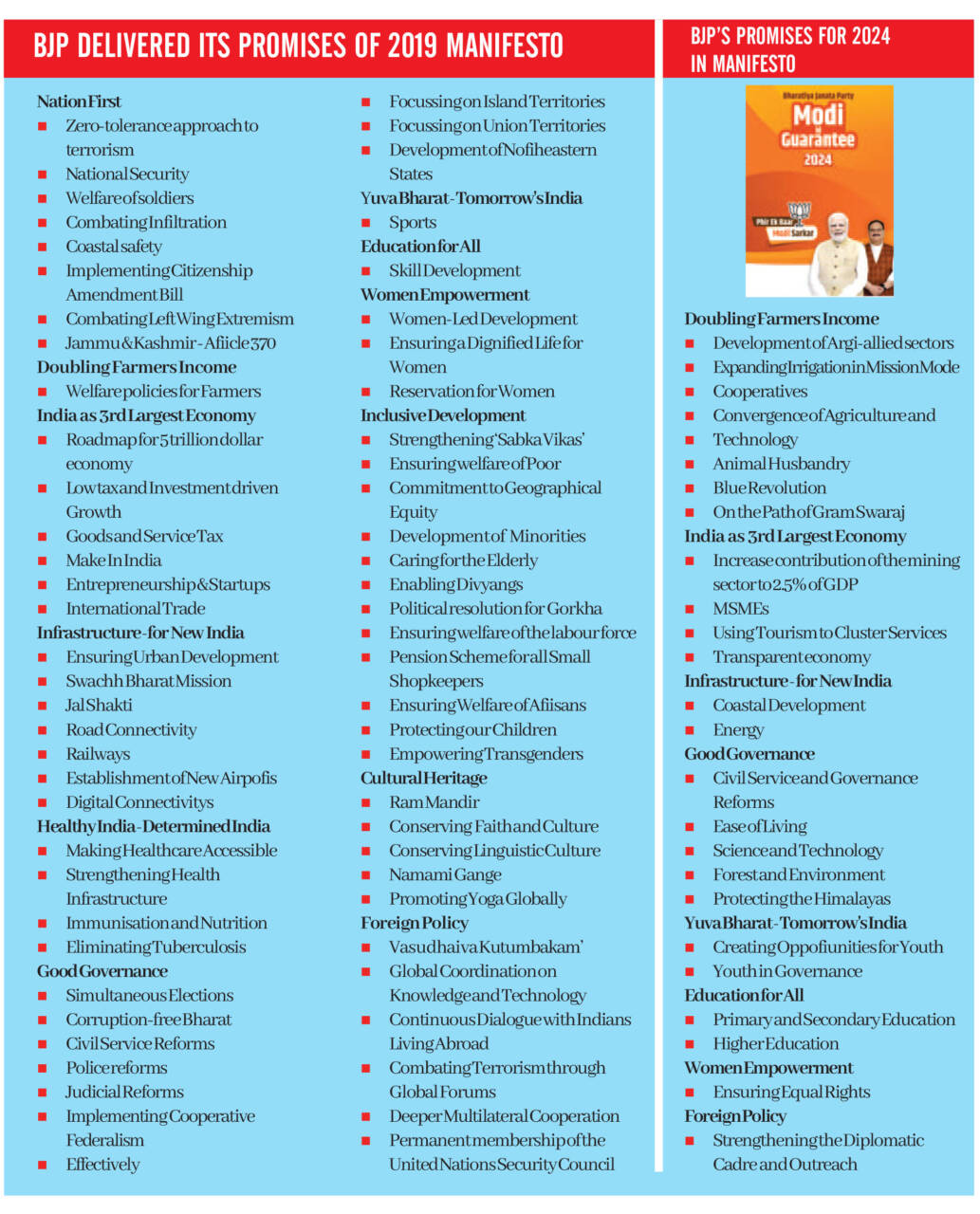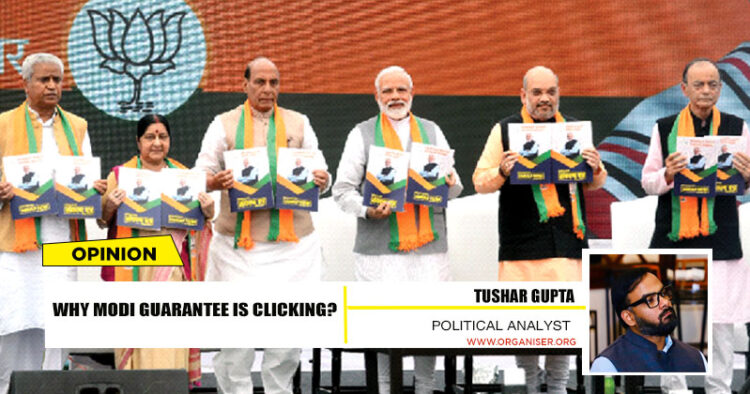Around this time, next month, Prime Minister Narendra Modi will complete ten years in the Lok Kalyan Marg. In the past decade, he has led one of the strongest and most stable Governments in independent India. In 2014, for the first time in 30 years, the country voted for a decisive mandate. The faith in Modi was sustained by the people of India, and it had a bigger mandate in 2019. This was a young India telling the world that the era of weak coalition Governments was behind us. They wanted political stability to usher in economic progress, and Modi was the man they believed in.
As the Prime Minister, quite like his days as the Chief Minister, Modi has been a man of his word, even when his second tenure was rocked by two global events. While the second tenure started with a lot of promise, with the abrogation of Article 370 and the introduction of the Citizenship Amendment Act, the nation was soon engulfed by the doom of an unprecedented pandemic in March 2020.
In India’s history, only the Modi Government can claim the unique achievement of witnessing their three Budgets being sent for a toss, first by the nationwide lockdown in March 2020, then the Delta wave in April 2021, and finally, the Russia-Ukraine war, merely weeks after the Budget was presented in the Parliament.
Nevertheless, a decade later, Modi fulfilled all the big promises from 2014 and 2019, the most notable being completed in January earlier this year. For a billion Hindus, the Pran Pratishtha ceremony was an event they were privileged to witness in their lifetime. A wait of five centuries, with countless documented and some forgotten sacrifices, was over, and at the helm of affairs was Modi. The Rashtriya Swayamsevak Sangh (RSS) took the celebration to every household, with the akshat reaching every home across cities and villages.
The manufacturing giants are bullish on the India growth story as well. In FY24 alone, Apple manufactured $14 billion worth of iPhones in India
Even on the issue of agriculture, given the noise around the farm laws, the Modi Government has come out on top. The value of procurement at MSP for paddy has increased almost three-fold between 2014 and 2021 when compared to the seven preceding years of the UPA. For wheat, it has doubled in the same period, with farmers now getting MSP directly into their bank accounts without the interference of middlemen. However, the private sector is also leading the transformation. For instance, the northeast states have registered an exponential increase in their horticulture exports.
Meghalaya’s pineapples, one that Rahul Gandhi was fondly promoting, are already being exported to the West Asia. By November 2023, the Modi Government had registered over 7,500 Farmer Producer Organisations (FPOs) that will help small and marginal farmers increase their incomes and lower their input costs.
In a recently published article in a foreign publication, it was proposed that India may have followed the same growth trajectory even without Modi’s elevation. However, most of these observers miss the socio-economic transformation of rural micro ecosystems.
Beyond the 52 crore Jan Dhan Accounts, 46 Crore MUDRA loans, over 11 crore tap water connections, 3 crore houses, 10-odd crore gas cylinders for better kitchens, and medical coverage for 50 crore people under the Ayushman Bharat Yojana, there is a growing demand amongst two-thirds of the nation’s population. In the last ten years, they have taken out the perpetual struggle of roti, kapda, aur makaan.

The transformation of the rural ecosystem was visible in the recently released MPCE (Monthly Per Capita Expenditure) numbers. The non-food expenditure in the rural areas has increased by over 12 per cent, with expenditure on household consumables going up by 27 per cent, a mammoth 78 per cent increase in conveyance, a 10 per cent increase in entertainment, and a 42 per cent increase in durable goods. For India’s young MSMEs, now settled into the Goods and Services Tax (GST) regime, a new market of over 800 million people has opened up for the forthcoming decade.
The manufacturing giants are bullish on the India growth story as well. In FY24 alone, Apple manufactured $14 billion worth of iPhones in India. The same report from a business news group stated that 14 per cent of Apple’s manufacturing was now happening in India. By FY26, 25 per cent of Apple’s global production could happen in India. The Production-Linked Incentive scheme has already generated more than Rs. 1 lakh crore in investments and created over 700,000 direct jobs.
The exports under the PLI have been over Rs 3.4 lakh crore, production/sales worth Rs. 8.7 lakh crore and the spillover effect is already reaching India’s MSMEs and labour market. Despite the lofty numbers, India’s manufacturing story has barely begun. However, from struggling for APIs (Active Pharmaceutical Ingredients) at the beginning of COVID-19 to embedding itself in the global supply chain in 2024, the turnaround has been nothing less than tectonic.
Modi’s bet on Digital India has also paid off. While the opposition was critical of both the Jan Dhan Yojana and digital payments, today, over 13 billion transactions are being recorded (in value for March 2024). Fifty two crore Jan Dhan accounts have deposits that exceed Rs. 200,000 crore.
Physical infrastructure is also making headlines. In his push for infrastructure, Modi has displayed a progressive obsession that may remind one of President Franklin D Roosevelt of the United States of America in the 1930s.
For FY25 alone, the interim budget set aside Rs 11 lakh crore for infrastructure. Projects like the Dedicated Freight Corridor (DFCs), plagued by disruptions during the Congress era without a single kilometre being constructed, are now being pursued in hyperdrive mode. By September 2023, over 100,000 trains had completed their run on the DFCs, instrumental in bringing down the logistics and export costs for MSMEs.
As the leader of the world’s largest democracy, Modi checks all boxes across the socio-economic spectrums. In the last decade, his reforms have enabled a billion people, putting them on the path of atmanirbharta. Perhaps that also explains why the voters have repeatedly rejected the freebies of Congress, first in 2019 (the promise of Rs. 72,000 annually) and subsequently in 2022 and 2023 in the majority of state assembly elections. In 2024, Congress’ promise of Rs. 100,000 to poor households is not getting much traction and is being ridiculed instead. The transformed India under Modi does not want dependency on the state.
One of the most underrated achievements of Modi, however, will be the management of the economy during Covid–19 times. Quite like his counterparts in the West, and against the suggestion by a few politicians masquerading as economists, Modi chose not to rely on generous cash transfers alone to help the people during the lockdown. Instead, an agile approach was undertaken that started with the Pradhan Mantri Garib Kalyan Anna Yojana for 80 crore people, followed by the Emergency Credit Guarantee Line Scheme (ECGLS) that saved over 14.5 lakh MSMEs, prevented loans worth Rs 2 trillion (12 per cent of outstanding MSME credit) from turning into NPAs, and saved over 16 million jobs. The two billion doses, procured, distributed, and administered in record time, were the ideal healing touch the country needed to get out of the pandemic.
Today, globally, no one wants to miss the India’s growth story, even Elon Musk. Modi’s India is drawing from its civilisational greatness to rise in an uncertain global order but on its terms and conditions.


















Comments